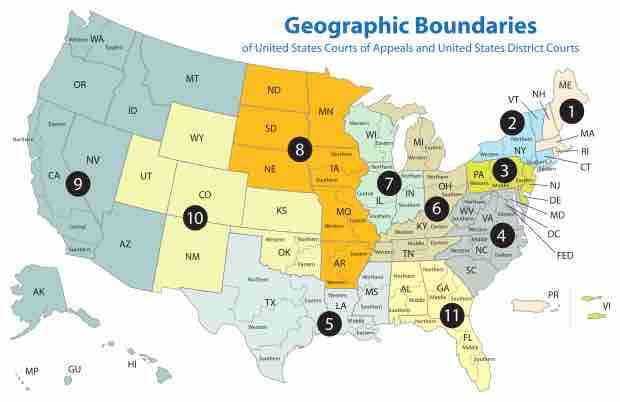The U.S. federal courts of appeals, also known as appellate courts or circuit courts, hear appeals from district courts as well as appeals from decisions of federal administrative agencies. There are thirteen courts of appeals, twelve of which are based on geographic districts called circuits. These twelve circuit courts decide whether or not the district courts within their geographic jurisdiction have made an error in conducting a trial . The thirteenth court of appeals hears appeals from the Court of International Trade, the U.S. Court of Federal Claims, the Patent and Trademark Office, and others.

US Court of Appeals and District Court Map
Courts of Appeals, with the exception of one, are divided into geographic regions known as circuits that hear appeals from district courts within the region..
Every federal court litigant has the right to appeal an unfavorable ruling from the district court by requesting a hearing in a circuit court. However, only about 17% of eligible litigants do so because of the expense of appealing. In addition, few appealed cases are heard in the higher courts. Those that are, are rarely reversed.
Procedure
The procedure within appellate courts diverges widely from that within district courts. First, a litigant who files an appeal, known as an appellant, must show that the trial court or an administrative agency made a legal error that affected the decision in the case. Appeals are then passed to a panel of three judges working together to make a decision. These judges base their decision on the record of the case established by the trial court or agency. The appellant presents a document called a brief, which lays out the legal arguments to persuade the judge that the trial court made an error. Meanwhile, the party defending against the appeal, known as the apellee, also presents a brief presenting reasons the trial court decision is correct or why an error made by the trial court is not significant enough to reverse the decision. The appellate judges do not receive any additional evidence or hear witnesses.
While some cases are decided on the basis of written briefs alone, other cases move on to an oral argument stage. Oral argument consists of a structured discussion between the appellate lawyers and the panel of judges on the legal principles in dispute. Each side is given a short time to present their arguments to the judges. The court of appeals decision is usually the final word in the case unless it sends the case back to the trial court for additional proceedings. A litigant who loses in the federal courts of appeals may also ask the Supreme Court to review the case.
Legal Precedent
The U.S. courts of appeals are among the most powerful and influential courts in the United States. Decisions made within courts of appeals, unlike those of the lower district courts, establish binding precedents. After a ruling has been made, other federal courts in the circuit must follow the appellate court's guidance in similar cases, even if the trial judge thinks that the case should be handled differently. In addition, the courts of appeals often serve as the final arbiter in federal cases, since the Supreme Court hears less than 100 of the over 10,000 cases sent to it annually.